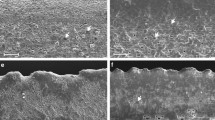Abstract
The genus Chrysophthalmum (Asteraceae) is represented by five species in the world. Three species of this genus are naturally grown in Turkey. The species growing in Turkey are C. montanum (DC.) Boiss., C. dichotomum Boiss. and Heldr. and C. gueneri Aytac and Anderb. Except C. montanum; the other species are endemic for Turkey. In the present study, micromorphological and anatomical characteristics of these species by using light microscopy (LM) and scanning electron microscopy (SEM) have been comparatively presented for the first time. The micromorphological studies are related to trichomes and cypsela. In anatomical studies, cross-sections of the stem, and leaf have been examined. In addition, to show stomatal distribution and anatomy on adaxial and abaxial leaves, surface sections of the leaves have been taken and stomatal index calculated. The features of stems, leaves, trichomes and cypsela have been found to be significant to distinguish the species. Mesophyll structure, number of vascular bundles in midrib, presence or absence of sclerenchymatous fibers in leaf, trichome types, presence or absence of pappus in cypsela, presence or absence of hair on cypsela surface are important diagnostic characters. A diagnostic key based on combined leaf, trichome and cypsela characteristics of the Chrysophthalmum species has been given.






Similar content being viewed by others
References
Hind DJN, Beentje HJ (1994) Compositae: systematics. Proceedings of the International Compositae Conference, Kew 1:1–7
Doğan B, Duran A, Hakkı E (2009) Numerical analyses of wild Jurinea spp. (Asteraceae) in Turkey. Bangladesh J Bot 38(1):47–53
Bremer K (1994) Compositae, cladistics and classification. Timber, Portland
Martin E, Çetin Ö, Makbul S et al (2012) Karyology of the Scorzonera L. (Asteraceae) taxa from Turkey. Turk J Biol 36:187–199
Anderberg AA, Baldwin BG, Bayer RG et al (2007) Compositae. In: Kadereit JW, Jeffrey C (eds) The families and genera of vascular plants, vol 8. Springer, New York, pp 61–621
Davis PH (1975) Flora of Turkey and the East Aegean Islands, vol 5. Edinburgh University Press, Edinburgh
Davis PH, Tan K, Mill RR (1988) Flora of Turkey and the East Aegean Islands, vol 10. Edinburgh University Press, Edinburgh
Özhatay N, Kültür Ş (2006) Check–list of additional taxa to the supplement Flora of Turkey III. Turk J Bot 30:281–316
Grierson AJC (1975) Chrysophthalmum Schultz Bip. In: Davis PH (ed) Flora of Turkey and the East Aegean Islands, vol. 5. Edinburgh University Press, pp 52–53
Rechinger KH (1980) Chrysophthalmum Schultz–Bip. In Kotschy. In: Rechinger KH (ed) Flora Iranica 145. Compositae IV–Inuleae. Akademische Druck und Verlagsanstalt, Graz, pp 131–132
Aytac Z, Anderberg AA (2001) A new species of Chrysophthalmum Schultz Bip. (Asteraceae–Inuleae) from Turkey. Bot J Linn Soc 137:211–214
Metcalfe CR, Chalk L (1950) Anatomy of dicotyledons. Clarendon, Oxford
Dar GH, Khuroo AA, Reddy CS, Malik AH (2012) Impediment to taxonomy and its impact on biodiversity science: an Indian perspective. Proc Natl Acad Sci India Sect B Biol Sci 82(2):235–240
Hoşgören H, Saya Ö (2006) Chromosome numbers in two species of Onobrychis Miller. Adv Food Sci 28(2):120–122
Khatun S, Cakilcioglu U, Chatterjee NC (2011) Pharmacognostic value of leaf anatomy and trichome morphology for identification of forskolin in a novel medicinal plant Coleus forskohlii Briq. Biol Diver Conserv 4(2):165–171
Polat R, Satıl F, Selvi S (2010) Anatomical and ecological investigations on some Salvia L. (Lamiaceae) spe-cies growing naturally in the vicinity of Balıkesir. J Appl Biol Sci 4(2):29–33
Rao RR (2012) Plant taxonomy in tropical countries: a plea for urgent resurrection. Proc Natl Acad Sci India Sect B Biol Sci 82(2):259–264
Sharma G (2013) Role of phytochemicals and nucleic acids in solving taxonomic problems. Proc Natl Acad Sci India Sect B Biol Sci 83(2):141–145
Yakar-Tan N (1982) Bitki mikroskopisi klavuz kitabı. İstanbul University, Faculty of Science Publishing, İstanbul
Meidner H, Mansfield TA (1968) Physiology of stomata. McGraw–Hill, New York
Dilcher D (1974) Approaches to the identification of angiosperm leaf remains. Bot Rev 40(1):3–157
Wilkinson HP (1979) The plant surface (mainly leaf). In: Metcalfe CR, Chalk L (eds) Anatomy of the dicotyledons, vol I. Clarendon, Oxford, pp 97–165
Milan P, Hissae AH, Gloria BA (2006) Comparative leaf morphology and anatomy of three Asteraceae species. Braz Arch Biol Technol 49:135–144
Stebbins GL (1953) A new classification of the tribe Cichoriae, family Compositae. Madrono 12:65–81
Faust WZ, Jones SB (1973) The systematic value of trichome complements in a North American group of Vernonia (Compositae). Rhodora 75:517–528
Napp-Zinn K, Eble M (1980) Beitrage zur systematischen Anatomie der Asteraceae–Anthemideae: Die Trichome. Plant Syst Evol 136:169–207
Sahu TR (1982) Trichome studies in Parthenium hysterophorus and their taxonomic importance. Feddes Repert 93:437–441
Sahu TR (1984) Taxonomic implications of trichome complements to Vernonia (Compositae) in India. Feddes Repert 95:237–249
Hoot SB (1991) Phylogeny of the Ranunculaceae based on epidermal microcharacters and macromorphology. Syst Bot 16:741–755
Al-Shamary KIA, Gornall RJ (1994) Trichome anatomy of the Saxifragaceae s. l. from the southern hemisphere. Bot J Linn Soc 114:99–131
Krak K, Mraz P (2008) Trichomes in the tribe Lactuceae (Asteraceae) taxonomic implications. Biologia 63(5):616–630
Kallersjö M (1986) Fruit structure and generic delimitation of Athanasia (Asteraceae–Anthemideae) and related South African genera. Nordic J Bot 5:527–542
Mukherjee SK, Sarkar AK (2001) Morphology and structure of Cypsela in thirteen species of the tribe Astereae (Asteraceae). Phytomorphology 51(1):17–26
Ciccarelli D, Garbari F, Pagni AM (2007) Glandular hairs of the ovary: a helpful character for Asteroideae (Asteraceae) taxonomy? Ann Bot Fennici 44:1–7
Acknowledgments
The authors are grateful to Basic Sciences Research and Applied Center of Balikesir University (BUTAM) for SEM studies.
Author information
Authors and Affiliations
Corresponding author
Rights and permissions
About this article
Cite this article
Selvi, S., Paksoy, M.Y., Polat, R. et al. Micromorphological and Anatomical Characteristics of the Genus Chrysophthalmum Schultz Bip. (Asteraceae) Growing in Turkey. Proc. Natl. Acad. Sci., India, Sect. B Biol. Sci. 84, 431–438 (2014). https://doi.org/10.1007/s40011-013-0231-5
Received:
Revised:
Accepted:
Published:
Issue Date:
DOI: https://doi.org/10.1007/s40011-013-0231-5




